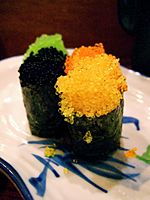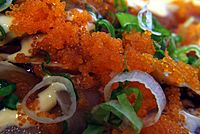Tobiko facts for kids
Tobiko (とびこ) is the Japanese word for flying fish roe. Roe means fish eggs. Tobiko is most famous for being used in different kinds of sushi.
What is Tobiko?
Tobiko comes from flying fish. These tiny eggs are a popular ingredient in Japanese cuisine. They add a special crunch and a mild, salty taste to many dishes.
Size and Texture
Tobiko eggs are very small, usually between 0.5 and 0.8 millimeters. To give you an idea, they are bigger than masago (which are capelin fish eggs). But they are smaller than ikura (which are salmon fish eggs). Natural tobiko has a bright red-orange color. It tastes a little smoky or salty and has a fun, crunchy texture when you eat it.
Colorful Tobiko!
Sometimes, tobiko is colored to make it look different. This is done using natural ingredients. For example, squid ink can make it black. Yuzu (a type of citrus fruit) can make it a pale orange or almost yellow. And wasabi can make it green and a bit spicy! When you see tobiko served, you might find several pieces, each with a different, exciting color.
How Tobiko is Used
Tobiko is used in many Japanese dishes. When it's prepared as sashimi, it might be served on top of avocado slices. It's also a common ingredient in popular California rolls. It adds a great flavor and texture to these dishes. Sometimes, masago (eggs from capelin or smelt fish) is used instead of tobiko. This is because they look and taste similar. However, people who eat a lot of sushi can often tell the difference because masago eggs are even smaller.
See also
 In Spanish: Tobiko para niños
In Spanish: Tobiko para niños



